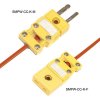thibault
Member
- Joined
- Oct 25, 2009
- Messages
- 191
Has anyone else had trouble with erratic EGT/CHT indications using the Dynon supplied sensors?
Been flying for years and putting up with erratic indications. Have gone over all the crimps with a quality ratcheting crimper with some improvement, but it doesn't last. Have replaced the EGT sensors after many years, when they wore out, and the problem returned with the new ones as well.
Finally decided to cut off the fast-on style connectors and just butt splice the ends together. This meant that I stripped the sensor end for the first time (these come with the connector already on that end). When stripping that end of EGT or CHT, I noticed that there is a woven insulator under the plastic. It is a pain in the butt to get rid of that stuff, but I did and crimped on the butt connector. The brownish wire that goes to the EMS box has only the plastic insulation, so it strips easily.
I wonder if the factory supplied sensors have less than ideal assembly techniques and that this compromises the signal integrity.
In any case, after one test flight the readings are again very steady. For now, at least.........
Been flying for years and putting up with erratic indications. Have gone over all the crimps with a quality ratcheting crimper with some improvement, but it doesn't last. Have replaced the EGT sensors after many years, when they wore out, and the problem returned with the new ones as well.
Finally decided to cut off the fast-on style connectors and just butt splice the ends together. This meant that I stripped the sensor end for the first time (these come with the connector already on that end). When stripping that end of EGT or CHT, I noticed that there is a woven insulator under the plastic. It is a pain in the butt to get rid of that stuff, but I did and crimped on the butt connector. The brownish wire that goes to the EMS box has only the plastic insulation, so it strips easily.
I wonder if the factory supplied sensors have less than ideal assembly techniques and that this compromises the signal integrity.
In any case, after one test flight the readings are again very steady. For now, at least.........

